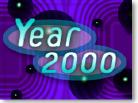|
Funds are ready for Y2K
|
 |
May 23, 1999: 7:57 a.m. ET
SEC has put the heat on financial institutions to prepare for the millennium
|
NEW YORK (CNNfn) - As you ring in the new millennium on Dec. 31, fund giant Vanguard Group may have fuel oil tankers parked in the driveway in case of a power outage.
While Vanguard doesn't expect planes to fall out of the sky or any other calamities predicted for 2000, it has spent roughly $50 million over three years checking every system, every software product and every computer.
The company has run hundreds of "what if" tests, prepared contingency plans and spent hours with banks and other outside partners it communicates with electronically.
"I think we're in good shape," said Robert DiStefano, managing director of Internet technology at Vanguard. "Certainly some things will go bump in the night. There will be delays, slowdowns. But there will be a lot of comfort given to people that everything is OK."
The Securities and Exchange Commission established a string of guidelines for fund companies and formed a task force to track their progress. The panel required fund companies and their advisors to disclose any effects of the Y2K problem. Fund companies filed their most recent reports on April 30.
The SEC also required 400 investment firms and fund companies to participate in a series of tests sponsored by the Securities Industry Association on Wall Street.
"We feel comfortable with the industry as a whole," said SEC commissioner Laura Unger. While smaller fund companies might not have as much money to spend, the SEC isn't aware of any specific problems.
Fund companies have until Aug. 30 to finish their plans, and the SEC has the power to shut down a fund company if it isn't Y2K compliant by then.
James Punishiller, an analyst at Forrester Research in Boston, said the SEC and the National Association of Securities Dealers have been pounding the financial industry to prepare for the millennium.
"These guys have been working on this for years," Punishiller said. "They are way, way ahead of the game."
Bert McConnell, executive vice president in charge of the Y2K program at Fidelity Investments, said the Boston fund giant will spend the rest of 1999 doing more testing. Fidelity has spent about $300 million on its Y2K program, he said.
"We keep saying this will be just another day in business," McConnell said.
Besides fixing computers to read the year 2000 and doing simulations of what the trading days will be like on Dec. 31 through early January 2000, Fidelity is also trying to anticipate any possible problem.
"It's all the 'what ifs'," McConnell said. "What if we miss something in our systems, what if one of our providers has a problem … then we break that down and look at the high probability events with a high impact."
But there are still some unknowns. For example, a big concern is how international markets will handle the transition, said DiStefano.
Since the millennium will arrive in Russia, New Zealand, Tokyo and other parts of the world early on Dec. 31 EST, investors may panic if there's unrest in global markets. One industry concern is that investors will pull their money out of U.S. markets that day, creating volatility.
"I don't know how to predict investor psychology," DiStefano said. "That's probably the biggest issue domestically."
Another possibility is that investors would pull their money out of the U.S. market a few days beforehand, perhaps on Dec. 29, and then put their money back in on Jan. 5.
"There's a psychology out there that we're all concerned about, (but) all we can do is assure investors that we've taken every step to mitigate their concerns," McCall said.
Both Fidelity and Vanguard are expanding their Web capacity and adding new phone lines to handle an expected flood of calls if investors want to check on their holdings Jan. 1.
DiStefano thinks at worst the transition could be comparable to an extremely heavy trading day.
He said the heaviest trading days he's seen were during the market crash of October 1987. He said investors who pulled their money out during those dark days also missed out on the big gains that followed.
"The U.S. financial industry is in better shape compared with the rest of the United States, and in great shape compared with the rest of the world," DiStefano said.
-- by staff writer Martine Costello
|
|
|
|
|
 |

|

